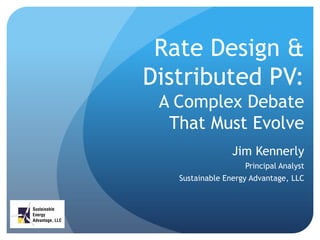Report
Share
Download to read offline

Recommended
Recommended
Presented by Hans Nilsson, FourFact, Sweden, former Chairman of the IEA DSM Programme, at present Advisor to the IEA DSM Programme at the IEA DSM workshop in Espoo, Finland on 14 November 2012.DSM in the 21st Century - Large Scale Deployment of smart applications 

DSM in the 21st Century - Large Scale Deployment of smart applications IEA DSM Implementing Agreement (IA)
More Related Content
Similar to JDK SPI 2015 Rate Design Presentation
Presented by Hans Nilsson, FourFact, Sweden, former Chairman of the IEA DSM Programme, at present Advisor to the IEA DSM Programme at the IEA DSM workshop in Espoo, Finland on 14 November 2012.DSM in the 21st Century - Large Scale Deployment of smart applications 

DSM in the 21st Century - Large Scale Deployment of smart applications IEA DSM Implementing Agreement (IA)
Similar to JDK SPI 2015 Rate Design Presentation (20)
Assessing Benefits and Costs of Distributed Solar Resources

Assessing Benefits and Costs of Distributed Solar Resources
Utility megatrends and contact center transformations

Utility megatrends and contact center transformations
Utilities, regulators & distributed solar generation rethinking utility busi...

Utilities, regulators & distributed solar generation rethinking utility busi...
Transforming the utilities industry through bpo by teleperformance

Transforming the utilities industry through bpo by teleperformance
Richard Cowart - Delivering Energy Efficiency on a Large Scale: Challenges an...

Richard Cowart - Delivering Energy Efficiency on a Large Scale: Challenges an...
Delivering New Energy Experiences for Future Growth

Delivering New Energy Experiences for Future Growth
Delivering New Energy Experiences for Future Growth

Delivering New Energy Experiences for Future Growth
Solving for the equation for disruption to the U.S. electric power industry

Solving for the equation for disruption to the U.S. electric power industry
20151022 SEPA Deora Slides for Deloitte Solar Growth Dbrief

20151022 SEPA Deora Slides for Deloitte Solar Growth Dbrief
"Next Gen Grid Tech Commercialization" for Duke University Energy Initiative ...

"Next Gen Grid Tech Commercialization" for Duke University Energy Initiative ...
DSM in the 21st Century - Large Scale Deployment of smart applications 

DSM in the 21st Century - Large Scale Deployment of smart applications
Community Choice 2.0 & 3.0 "Tutorial Workshop" Agenda

Community Choice 2.0 & 3.0 "Tutorial Workshop" Agenda
Shared Economy & Open Data in #EnergyEfficiency Markets

Shared Economy & Open Data in #EnergyEfficiency Markets
More from Jim Kennerly
More from Jim Kennerly (6)
Going Solar in America - Ranking Solar's Value to Customers_FINAL

Going Solar in America - Ranking Solar's Value to Customers_FINAL
JDK SPI 2015 Rate Design Presentation
- 1. Rate Design & Distributed PV: A Complex Debate That Must Evolve Jim Kennerly Principal Analyst Sustainable Energy Advantage, LLC
- 2. About Sustainable Energy Advantage, LLC Renewable energy consulting and advisory firm focused on the Northeast Services include: renewable energy market, policy, financial & strategic analysis, due diligence Recent engagements include: MA Net Metering and Solar Task Force NY Large-Scale Renewables (LSR) Program Development RI Renewable Energy Growth Program Various consulting projects and subscription services for private clients (including but not limited to):
- 3. Why Is Good Rate Design Important? It needs to affordably convey the value of grid service to customers, and allow utilities to profitably offer it. It needs to convey the value of reasonable “alternatives to service” that permit resource efficiency. So…what if it doesn’t? Excessive volumetric charges could undervalue aspects of utility service, and (if there’s enough solar/DER) bankrupt the utility. Excessive fixed charges could undervalue alternatives to service, and thus resource efficiency, and (if the rates have a big enough fixed charge) could bankrupt solar/DER companies.
- 4. Distributed PV: A Clash of Cost/Benefit Perspectives (Utilities/Allies) Distributed solar is unfair for a subset of customers that cannot “afford” it, and shifts costs to these customers because the “value of solar” is less than the retail rate. (Solar Advocates/Industry) Not enough at the retail rate, because the “value of solar” meets or exceeds the retail rate
- 5. Why the Debate Must Evolve From “Either/Or” to “Both/And” Role of Solar/Wind in the Clean Power Plan’s “Clean Energy Incentive Program” Declining traditional incentives, declining load & load factor New distributed energy resource (DER) technology & the advent of “Demand Flexibility” The immense social value of DER soft cost reduction Changes in solar value to grid/society with higher penetrations The Bottom Line: Change means that utility rates must reflect a new standard of fully-loaded DER value that enables a transition to a sustainable, value- creating DER market.
- 6. So…how do we get there? Key Point from Getting to Yes: Focus on interests, not positions. Mick Jagger Translation: You can’t always get what you want…but if you try sometimes, you might find you get what you need.
- 7. Questions 1 of 5
- 8. Questions 2 of 5
- 9. Questions 3 of 5
- 10. Questions 4 of 5
- 11. Questions 5 of 5
